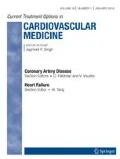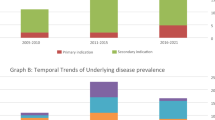Opinion statement
The vast majority of implantable cardioverter defibrillators (ICDs) continue to be implanted in the adult population. Accordingly, manufacturers develop devices and leads primarily for the adult population. Whilst the number of ICDs implanted in children is small in comparison, the potential benefits are large to this group. It is a common frustration among pediatric cardiologists whom implant devices that impressive technological developments continue to be developed for the adult population; as the population of children with ICDs is small, robust clinical studies often lag behind. By necessity, pediatric cardiologists and cardiothoracic surgeons have developed innovative techniques utilizing adult components in unusual configurations for children with complex congenital heart disease. As in the adult population, inappropriate shocks are one of the most limiting and concerning complications in the use of ICDs. Unfortunately, as will be discussed below, children are at increased risk of inappropriate shocks when compared with adults. The true impact of inappropriate shocks is increasingly being realized, and much of the focus in management of children with ICDs surrounds the prevention of inappropriate shocks.
Similar content being viewed by others
References and Recommended Reading
Papers of particular interest, published recently, have been highlighted as: • Of importance •• Of major importance
Mirowski M, et al. Termination of malignant ventricular arrhythmias with an implanted automatic defibrillator in human beings. N Engl J Med. 1980;303(6):322–4.
Winkle RA, et al. Long-term outcome with the automatic implantable cardioverter-defibrillator. J Am Coll Cardiol. 1989;13(6):1353–61.
Fitzpatrick AP, et al. Electrophysiological laboratory, electrophysiologist-implanted, nonthoracotomy-implantable cardioverter/defibrillators. Circulation. 1994;89(6):2503–8.
Kron J, et al. Preliminary experience with nonthoracotomy implantable cardioverter defibrillators in young patients. The Medtronic Transvene Investigators. Pacing Clin Electrophysiol. 1994;17(1):26–30.
Eisenberg M, Bergner L, Hallstrom A. Epidemiology of cardiac arrest and resuscitation in children. Ann Emerg Med. 1983;12(11):672–4.
Von Bergen, N.H., et al. Multicenter study of the effectiveness of implantable cardioverter defibrillators in children and young adults with heart disease. Pediatr Cardiol, 2011, 32(4):399-405.
Berul CI, et al. Results of a multicenter retrospective implantable cardioverter-defibrillator registry of pediatric and congenital heart disease patients. J Am Coll Cardiol. 2008;51(17):1685–91.
Epstein AE, et al. ACC/AHA/HRS 2008 Guidelines for Device-Based Therapy of Cardiac Rhythm Abnormalities: a report of the American College of Cardiology/American Heart Association Task Force on Practice Guidelines (Writing Committee to Revise the ACC/AHA/NASPE 2002 Guideline Update for Implantation of Cardiac Pacemakers and Antiarrhythmia Devices) developed in collaboration with the American Association for Thoracic Surgery and Society of Thoracic Surgeons. J Am Coll Cardiol. 2008;51(21):e1–62.
The Antiarrhythmics versus Implantable Defibrillators (AVID) Investigators. A comparison of antiarrhythmic-drug therapy with implantable defibrillators in patients resuscitated from near-fatal ventricular arrhythmias. N Engl J Med. 1997;337(22):1576–83.
Siebels J, Kuck KH. Implantable cardioverter defibrillator compared with antiarrhythmic drug treatment in cardiac arrest survivors (the Cardiac Arrest Study Hamburg). Am Heart J. 1994;127(4 Pt 2):1139–44.
Connolly SJ, et al. Canadian implantable defibrillator study (CIDS): a randomized trial of the implantable cardioverter defibrillator against amiodarone. Circulation. 2000;101(11):1297–302.
Epstein AE, et al. ACC/AHA/HRS 2008 Guidelines for Device-Based Therapy of Cardiac Rhythm Abnormalities: a report of the American College of Cardiology/American Heart Association Task Force on Practice Guidelines (Writing Committee to Revise the ACC/AHA/NASPE 2002 Guideline Update for Implantation of Cardiac Pacemakers and Antiarrhythmia Devices): developed in collaboration with the American Association for Thoracic Surgery and Society of Thoracic Surgeons. Circulation. 2008;117(21):e350–408.
Schwartz PJ, et al. Prevalence of the congenital long-QT syndrome. Circulation. 2009;120(18):1761–7.
Horner, J.M., et al. Implantable cardioverter defibrillator therapy for congenital long QT syndrome: a single-center experience. Heart Rhythm, 2010, 7(11):1616-22.
Blaufox, AD, et al Congenital Long QT 3 in the Pediatric Population. Am J Cardiol, 2012.
Werf, C., A.H. Zwinderman, and A.A. Wilde Therapeutic approach for patients with catecholaminergic polymorphic ventricular tachycardia: state of the art and future developments. Europace, 2012, 14(2):175-83.
Khairy, P., et al. Risk stratification in surgically repaired tetralogy of Fallot. Expert Rev Cardiovasc Ther, 2009, 7(7):755-62.
Khairy P, et al. Implantable cardioverter-defibrillators in tetralogy of Fallot. Circulation. 2008;117(3):363–70.
Maron BJ, et al. Implantable cardioverter-defibrillators and prevention of sudden cardiac death in hypertrophic cardiomyopathy. JAMA. 2007;298(4):405–12.
Gersh BJ, et al. 2011 ACCF/AHA Guideline for the Diagnosis and Treatment of Hypertrophic Cardiomyopathy: a report of the American College of Cardiology Foundation/American Heart Association Task Force on Practice Guidelines. Developed in collaboration with the American Association for Thoracic Surgery, American Society of Echocardiography, American Society of Nuclear Cardiology, Heart Failure Society of America, Heart Rhythm Society, Society for Cardiovascular Angiography and Interventions, and Society of Thoracic Surgeons. J Am Coll Cardiol. 2011;58(25):e212–60.
Stephenson EA, et al. A multicenter experience with novel implantable cardioverter defibrillator configurations in the pediatric and congenital heart disease population. J Cardiovasc Electrophysiol. 2006;17(1):41–6.
Radbill AE, et al. System survival of nontransvenous implantable cardioverter-defibrillators compared to transvenous implantable cardioverter-defibrillators in pediatric and congenital heart disease patients. Hear Rhythm. 2010;7(2):193–8.
McLeod KA, McLean A. Implantation of a Fully Subcutaneous ICD in Children. Pacing Clin Electrophysiol. 2012;35(1):e20–3.
Korte T, et al. High incidence of appropriate and inappropriate ICD therapies in children and adolescents with implantable cardioverter defibrillator. Pacing Clin Electrophysiol. 2004;27(7):924–32.
Love BA, et al. Supraventricular arrhythmias in children and young adults with implantable cardioverter defibrillators. J Cardiovasc Electrophysiol. 2001;12(10):1097–101.
Cohen MI, et al. Limited utility of exercise-stress testing to prevent T-wave oversensing in pediatric internal cardioverter defibrillator recipients. Pacing Clin Electrophysiol. 2011;34(4):436–42.
Lawrence D, et al. Inappropriate ICD discharges in single-chamber versus dual-chamber devices in the pediatric and young adult population. J Cardiovasc Electrophysiol. 2009;20(3):287–90.
Alexander ME, et al. Implications of implantable cardioverter defibrillator therapy in congenital heart disease and pediatrics. J Cardiovasc Electrophysiol. 2004;15(1):72–6.
Botsch MP, et al. ICD therapy in children and young adults: low incidence of inappropriate shock delivery. Pacing Clin Electrophysiol. 2010;33(6):734–41.
van der Werf C, Zwinderman AH, Wilde AA. Therapeutic approach for patients with catecholaminergic polymorphic ventricular tachycardia: state of the art and future developments. Europace. 2012;14(2):175–83.
Goel AK, et al. Implantable cardioverter defibrillator therapy in children with long QT syndrome. Pediatr Cardiol. 2004;25(4):370–8.
Khairy, P. and F. Mansour Implantable cardioverter-defibrillators in congenital heart disease: 10 programming tips. Heart Rhythm, 2011, 8(3):480-3. This succinctly written article pulls together a wealth of experience in the management of ICDs and suggests strategies to reduce the burden of inappropriate therapy in the population at highest risk
Wathen MS, et al. Prospective randomized multicenter trial of empirical antitachycardia pacing versus shocks for spontaneous rapid ventricular tachycardia in patients with implantable cardioverter-defibrillators: Pacing Fast Ventricular Tachycardia Reduces Shock Therapies (PainFREE Rx II) trial results. Circulation. 2004;110(17):2591–6.
Lewandowski M, et al. Long-term follow-up of children and young adults treated with implantable cardioverter-defibrillator: the authors' own experience with optimal implantable cardioverter-defibrillator programming. Europace. 2010;12(9):1245–50.
Stephenson EA, et al. Utility of routine follow-up defibrillator threshold testing in congenital heart disease and pediatric populations. J Cardiovasc Electrophysiol. 2005;16(1):69–73.
Stephenson EA, Kaltman JR. Current state of the art for use of pacemakers and defibrillators in patients with congenital cardiac malformations. Cardiol Young. 2006;16 Suppl 3:151–6.
Varma N, et al. Efficacy and safety of automatic remote monitoring for implantable cardioverter-defibrillator follow-up: the Lumos-T Safely Reduces Routine Office Device Follow-up (TRUST) trial. Circulation. 2010;122(4):325–32.
Crossley GH, et al. The CONNECT (Clinical Evaluation of Remote Notification to Reduce Time to Clinical Decision) trial: the value of wireless remote monitoring with automatic clinician alerts. J Am Coll Cardiol. 2011;57(10):1181–9.
DeMaso DR, et al. Psychosocial factors and quality of life in children and adolescents with implantable cardioverter-defibrillators. Am J Cardiol. 2004;93(5):582–7.
Sears SF, et al. Quality of life in pediatric patients with implantable cardioverter defibrillators. Am J Cardiol. 2011;107(7):1023–7.
Koopman, H.M., et al. Psychological Functioning and Disease-Related Quality of Life in Pediatric Patients With an Implantable Cardioverter Defibrillator. Pediatr Cardiol, 2012.
Sears SF, St Amant JB, Zeigler V. Psychosocial considerations for children and young adolescents with implantable cardioverter defibrillators: an update. Pacing Clin Electrophysiol. 2009;32 Suppl 2:S80–2.
DeMaso DR, Neto LB, Hirshberg J. Psychological and quality-of-life issues in the young patient with an implantable cardioverter-defibrillator. Hear Rhythm. 2009;6(1):130–2.
Disclosure
No potential conflicts of interest relevant to this article were reported.
Author information
Authors and Affiliations
Corresponding author
Rights and permissions
About this article
Cite this article
Turner, C.J., Stephenson, E.A. Update on the Use and Outcomes of Implantable Cardioverter Defibrillators in Pediatric Patients. Curr Treat Options Cardio Med 14, 435–442 (2012). https://doi.org/10.1007/s11936-012-0202-9
Published:
Issue Date:
DOI: https://doi.org/10.1007/s11936-012-0202-9




